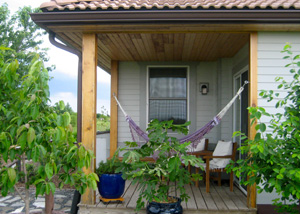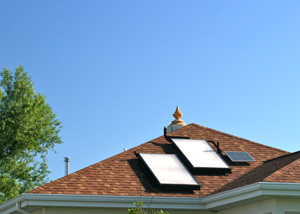House Design
Smart Construction
The average home in Fairfield uses approximately 1,500 kilowatts of electricity a month. An EcoVillage home averages 220 kilowatts per month. We achieve this dramatic reduction through highly integrated system designs, which harness intelligent energy found in the natural environment surrounding the home. With the use of special design techniques such as super insulation and passive solar design, we are able to improve the heating and cooling efficiency to a level which surpasses the most rigorous green building standards on the market today. By first improving the efficiency of the home, we are able to reduce the electrical loads required of our wind and solar systems. Below you will find just a few of the design principles we utilize in Abundance EcoVillage house design.
Passive Solar Design
 Passive Solar Design is the art of balancing the entire house, working with the sun’s energy to provide maximum climate control in any season. In our homes, window placement, overhang length, and flooring material help regulate the internal house temperature.
Passive Solar Design is the art of balancing the entire house, working with the sun’s energy to provide maximum climate control in any season. In our homes, window placement, overhang length, and flooring material help regulate the internal house temperature.
Window placement is calculated using the azimuth and altitude of the region. In Iowa, southern windows maximize heat during winter months. In the summer, the overhang, calculated at a precise angle, blocks direct sun, but still allows for significant day lighting. Windows on the North and West detract from climate comfort, and therefore are minimized. In addition, the sun porches on the southern side of the house acts as a passive heating unit during winter months. Our double-thick walls help to retain this precious heat , keeping residents toasty in the winter!
Super Insulation
 The EcoVillage houses feature a superior method of framing: 10 inch walls on a double stud frame. The average home in America is constructed with a 4-6” wall. Our 10” double thick walls and dual frame not only provide superior insulation, but also creates a remarkably solid structure that surpasses the most rigorous building inspection.
The EcoVillage houses feature a superior method of framing: 10 inch walls on a double stud frame. The average home in America is constructed with a 4-6” wall. Our 10” double thick walls and dual frame not only provide superior insulation, but also creates a remarkably solid structure that surpasses the most rigorous building inspection.
Electricity & Fuel
By nature of our highly efficient design, the energy for requirements EcoVillage homes are very low. Each household uses only a quarter of the electrical energy that the average American household uses. The village as a whole uses a fraction of what a standard development would use due to energy efficient buildings and produces a significant amount of its own energy, moving in the direction of 100% electrical production.
After several years with a centralized lead battery bank, we have decided to sell electricity to the “grid” and also to draw from the grid at times of low wind and sun. Because an ever increasing amount of Iowa energy is provided by the wind, much of what we draw from the grid is wind energy. What we sell to the grid is of course solar and wind. Having decided against using more lead batteries to store our power, we look forward to establishing a new bank using lithium batteries in the near future.
At the EcoVillage, 5 houses share a 30 amp circuit, whereas one standard home alone would have 200 amps. We can downsize this system because the house itself is more efficient, retaining heat in the winter and coolness in the summer. We utilize efficient lighting which runs no heat or excess energy, and several of our homes have an Earth Air Tubes climate control system for summer cooling and dehumidifying. This system uses a mere 70 watts of energy, whereas a small air conditioner typically uses 1200 watts.
The secondary energy system in an EcoVillage home is propane. Dryers, ranges, furnace, and backup for the solar hot water all run on propane. Although we’ve carefully designed each home to minimize propane use, propane requirements will vary from resident to resident, depending on living habits.
Solar Hot Water
 Solar hot water is the elegant solution to hot water needs. Specially designed for the Midwest region, the Abundance EcoVillage solar hot water system is a robust system that challenges the coldest of Iowa winters.
Solar hot water is the elegant solution to hot water needs. Specially designed for the Midwest region, the Abundance EcoVillage solar hot water system is a robust system that challenges the coldest of Iowa winters.
The roof or nearby ground of the home is outfitted with two thermal solar collectors. When the sun is shining, these generate heat. The collectors themselves contain absorption plates and heavy insulation to maximize the temperature. Inside the collectors is a network of copper tubing containing antifreeze that connects into the house, wrapping the interior of your solar hot water heater. The antifreeze moves within the copper tubing via a solar DC pump. This DC pump is also powered by the sun’s energy, running off the small photovoltaic plate that turns on or off depending on the amount of light detected. Thus the system monitors itself, operating only when enough sunlight is detected for the system to run efficiently.
When the hot water faucet is turned on, water flows from the solar hot water tank, to the secondary tank, which can be further heated by propane as necessary. From here the temperature is regulated, and the water will either be warmed or cool depending on the setting. Our solar hot water systems are designed to operate with little or no maintenance, so residents can rest easy knowing that the sun is doing all the work for you.










